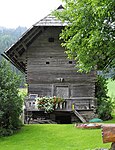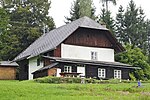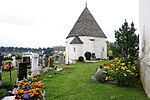List of listed objects in Gurk (Carinthia)
The list of listed objects in Gurk contains the 12 listed , immovable objects of the municipality of Gurk .
Monuments
| photo | monument | Location | description | Metadata |
|---|---|---|---|---|

|
Shrine Object ID: 103175 |
Alte Gurktalstraße Location KG: Gurk |
The old wayside shrine was renovated in 1968 and painted by Ria Mels-Colloredo. In 1992 a sheet metal roof was replaced by a stone slab roof. |
ObjectID : 103175 Status: § 2a Status of the BDA list: 2020-02-29 Name: wayside shrine GstNr .: 1305/2 wayside shrine in Gurk |

|
Entire system of cathedral monastery Gurk with fortifications and archaeological find hope area ObjektID : 110156 |
Domplatz 1, including location KG: Gurk |
Important Romanesque church from the 12th century, with a 100-column crypt and 60 m high pair of towers. Then the monastery building and partially preserved fortifications. |
ObjektID : 110156 Status: § 2a Status of the BDA list: 2020-02-29 Name: Entire complex of cathedral monastery Gurk with fortifications and archaeological find area GstNr .: 9; 1/2; 1/3; 4; 139; 140/2; 140/3; 669; 670; 671; 672; 673; .2 / 1; .2 / 2; .2 / 3; .3 / 1; .3 / 3; 10; 1/3; 3; 128; 140/1; 145/1; 145/2; .1; 626/2; 14; .58 / 1; .58 / 2 Gurk Cathedral |

|
Elementary school and kindergarten ObjectID : 61897 |
Dr.-Schnerich-Straße 8 KG location : Gurk |
Built in 1912 by the market town of Gurk, kindergarten since 1971. |
ObjectID : 61897 Status: § 2a Status of the BDA list: 2020-02-29 Name: Elementary school and kindergarten GstNr .: .112 |

|
Former Sawmill Building ObjectID : 44873 |
Hemmaweg 5 KG location : Gurk |
To the northwest of the Gurker Stiftsanlagen, a mighty two-storey solid building with a steep hipped roof, the substance of which goes back to the former bulk boxes. In the core 17th century, today's appearance from the reconstruction after fire in 1820. Remarkable purlin roof from the first half of the 19th century; rectangular, staggered brick lattice openings in the gable fields. At the SE corner of Wappenstein (marked 1691) by the builder Dompropst Johannes V. Wolfgang Lichtenstock von Liechtenheim (1688–1692). In the 19th and 20th Century sawmill, 1992/92 renovation for community purposes (museum). |
ObjectID : 44873 Status : Notification Status of the BDA list: 2020-02-29 Name: Former Sawmill building GstNr .: .5 Former. Sawmill building, Gurk |

|
Block memory Zechner ObjectID : 68096 |
Reichenhaus 9 KG location : Gurk |
A particularly remarkable, mighty grain box, marked 1762 with artistic corner connections. It belongs to a small group of around 10 block storage systems in the area between Sankt Andrä bei Weitensfeld and Sankt Peter ob Gurk, all probably by a carpenter around 1760. This box also has a zweigeschoßiger block memory Klingschrot as a corner joint, and the so-called Ansdach . |
ObjectID : 68096 Status : Notification Status of the BDA list: 2020-02-29 Name: Block storage Zechner GstNr .: .163 |

|
Immaculate column ObjectID: 103160 |
KG location : Gurk |
In the park on Domplatz in front of the cemetery gate. Inscribed 1855 on the base, neo-Gothic statue of the Virgin Mary. |
ObjectID: 103160 Status: § 2a Status of the BDA list: 2020-02-29 Name: Immaculatasäule GstNr .: 622/6 Immaculatasäule Gurk |

|
Figure shrine St. Johannes Nepomuk ObjectID : 103177 |
KG location : Gurk |
Posted at the old Gurkbrücke on Pisweger Straße. The statue dates from the second half of the 18th century and was restored in 1996. |
ObjectID : 103177 Status: § 2a Status of the BDA list: 2020-02-29 Name: Figurine picture stick hl. Johannes Nepomuk GstNr .: 622/9 |

|
Catholic branch church hll. Philip and James ObjectID : 62512 |
Masternitzen location KG: Gruska |
First mentioned in a document in 1285. Small mountain church with a wooden turret, retracted Gothic choir with a 5/8 end and a wooden vestibule. Gothic fittings and a key catch on the door of the west portal. Flat wooden ceiling in the nave; pointed triumphal arch. Choir ridge-arched. |
ObjectID : 62512 Status: § 2a Status of the BDA list: 2020-02-29 Name: Kath. Filialkirche hll. Philip and James GstNr .: .155 |

|
Weigand wall storage facility ObjectID : 48272 |
Sutsch 4 location KG: Gruska |
Toe box at the Weigandhof, “No. 7 ". Mentioned in a document in 1535. Leonhard Pirker, called "Zechner am Sutsch". The storage building erected in the early 16th century was used by the Gurk Cathedral Chapter to store manorial taxes. On the valley side, two-storey building made of quarry stone with a crooked hip roof; Facades with plaster from the 16th century, remnants of painted decorations on the northeast and southeast facade. Three key notches as late Gothic building details. On the ground floor, a very representative, late Gothic pillar hall, almost unchanged, four yokes with groin vaulted pointed barrels determine the floor plan structure of the remarkable one-pillar room. Eastern corner room on the upper floor with a Riemling ceiling from the 18th century. |
ObjectID : 48272 Status : Notification Status of the BDA list: 2020-02-29 Name: Mauerspeicher Weigand GstNr .: .122 Mauerspeicher Weigand, Gurk |

|
Residential building ObjectID : 61922 |
Gwadnitz 8 KG location : Pisweg |
ObjectID : 61922 Status: § 2a Status of the BDA list: 2020-02-29 Name: Wohnhaus GstNr .: .69 |
|

|
Catholic parish church hl. Lambert ObjectID : 62680 |
Pisweg location KG: Pisweg |
First mentioned in a document in 1164. The core of the Romanesque Gothic complex. 1994 interior restoration. Restoration of the baroque architectural polychromy, partial rearrangement of the furnishings Romanesque nave walls, retracted Gothic choir with two-tiered buttresses. Gothic tower on the south side of the choir, eight-sided distinctive Biedermeier helmet. Late Gothic flat ceiling in the nave; pointed triumphal arch; in the polygonal choir barrel vaults with stitch caps. Window with tracery noses (renewed). |
ObjectID : 62680 Status: § 2a Status of the BDA list: 2020-02-29 Name: Catholic parish church hl. Lambert GstNr .: .3 parish church hl. Lambert, Pisweg (Gurk) |

|
Cemetery with Karner ObjektID : 67978 |
Pisweg location KG: Pisweg |
Early Gothic, essentially late Romanesque rotunda from the 13th century with stepped console apse, conical roof, lancet window. 1946 Exposure of the swept lower wall zones by F. Walliser. 1960 conversion to a war memorial; at the same time, the small walled altar canteen was removed and the round-arched west portal was expanded to the outside in a funnel-shaped manner. The inner wall is divided by pilaster strips that continue in the dome as ribbon ribs. Extensive, well-preserved fresco furnishings, later zigzag style . Created around 1280, its iconography is based on the frescoes in the west gallery of Gurk Cathedral. In the apse Christ in the mandorla and angels; Madonna enthroned in the vault, paradise, fall, expulsion; on the side of the apse there are figures of saints; furthermore on the walls scenes from the life of Christ (Annunciation to Resurrection) and individual saints; Angel's ladder on the ribs, the Lamb of God on the keystone. On the Karner a Roman grave stele with an inscription for Respectianus and Quartus (CIL III 11593); in the floor of the carnelian a fragment of a grave inscription for Secundinus and Vindilla (ILLPRON 351). 1996 Exterior and interior restoration. Adaptation as a cemetery. |
ObjectID : 67978 Status: § 2a Status of the BDA list: 2020-02-29 Name: Friedhof mit Karner GstNr .: 5/2 Parish church hl. Lambert, Pisweg (Gurk) |
Web links
Commons : Listed Objects in Gurk - Collection of pictures, videos and audio files
Individual evidence
- ↑ a b Carinthia - immovable and archaeological monuments under monument protection. (PDF), ( CSV ). Federal Monuments Office , as of February 14, 2020.
- ↑ § 2a Monument Protection Act in the legal information system of the Republic of Austria .